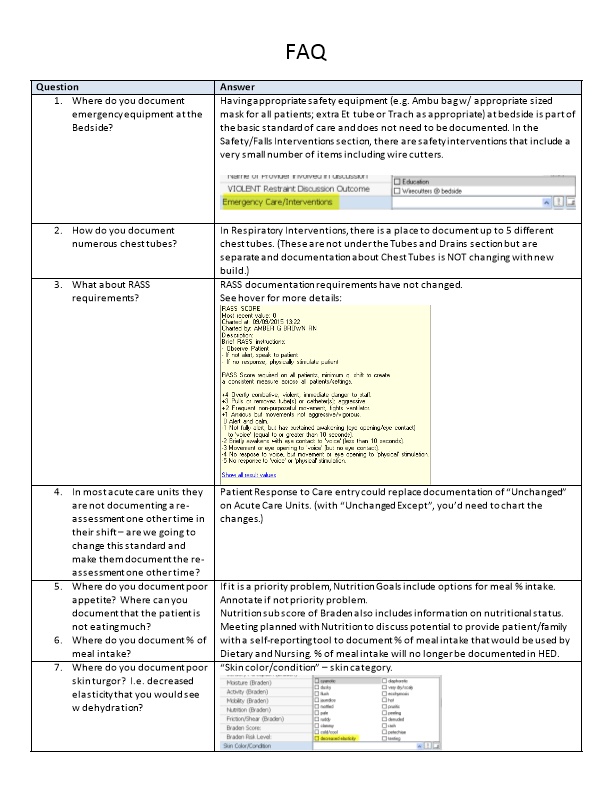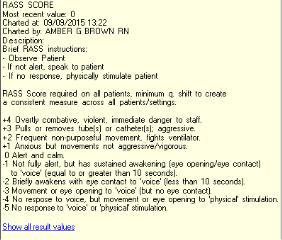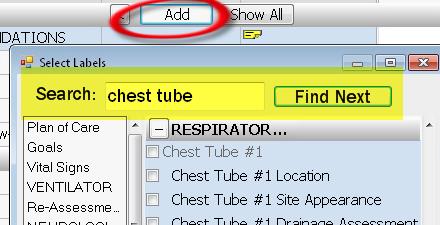Where Do You Document Emergency Equipment at the Bedside?

FAQ
Question / Answer
- Where do you document emergency equipment at the Bedside?
/ Having appropriate safety equipment (e.g. Ambu bag w/ appropriate sized mask for all patients; extra Et tube or Trach as appropriate) at bedside is part of the basic standard of care and does not need to be documented. In the Safety/Falls Interventions section, there are safety interventions that include a very small number of items including wire cutters.
- How do you document numerous chest tubes?
/ In Respiratory Interventions, there is a place to document up to 5 different chest tubes. (These are not under the Tubes and Drains section but are separate and documentation about Chest Tubes is NOT changing with new build.)
- What about RASS requirements?
/ RASSdocumentation requirements have not changed.
See hover for more details:

- In most acute care units they are not documenting a re- assessment one other time in their shift – are we going to change this standard and make them document the re-assessment one other time?
/ Patient Response to Care entry could replace documentation of “Unchanged” on Acute Care Units. (with “Unchanged Except”, you’d need to chart the changes.)
- Where do you document poor appetite? Where can you document that the patient is not eating much?
- Where do you document % of meal intake?
/ If it is a priority problem, Nutrition Goals include options for meal % intake. Annotate if not priority problem.
Nutrition sub score of Braden also includes information on nutritional status.
Meeting planned with Nutrition to discuss potential to provide patient/family with a self-reporting tool to document % of meal intake that would be used by Dietary and Nursing. % of meal intake will no longer be documented in HED.
- Where do you document poor skin turgor? I.e. decreased elasticity that you would see w dehydration?
/ “Skin color/condition” – skin category.
- There are normal listed when documenting IV site appearance- are there supposed to be?
/ “Normals” (dry/intact) will be removed.
- What is Respiratory Monitoring (Interventions)?
Is that pulse ox? / Monitoring respiration via bedside monitor, Covidien monitoring (SaO2, ETCO2), continuous pulse ox, etc. See hover for more details.
- Where do I chart HOB elevated?
/ In Activity/ Musculoskeletal Interventions, under positioning interventions.
- Are the ECMO, CRRT tabs staying?
/ Yes. Access from the “Chart” button if the tabs are not showing:
- Where is Pacemaker documentation?
- Berlin fields? (artificial heart)
/ See Device Tab
- How do you document Bowel Mgt systems – flushing, Initiation, status
/ GI interventions – “Bowel Mgt. care” means you provided care as specified in BMS procedure. No need to spell out each element.
- Why don’t we have the ability to say each goal is either met or not met?
/ In many cases, the answer is not just “yes”. By using a narrative entry under “Patient Response to Care”, richer detail can be included (e.g. What interventions did/did not contribute to improvement? If goal was not fully met, what would you recommend the oncoming nurse try based on your experience?) This is one of the key ways documentation “tells the patient story.”
- Where is documentation of: CVP (central venous pressure)
CVP reading in VS
What about Zero transducer?
Waveform? / In ICUs, CVP is generally done from the pressurized invasive monitoring line to that documentation is done under the art line assessment (which includes options about things like dampened wave forms, etc.) Zeroing transducer before documenting a value is standard of practice and does not need to be documented.
When CVPs are monitored outside of ICUs, they are generally done manually with a manometer and there is no waveform or transducer involved.
- Alarm limits?
/ There is a place at the bottom of the Device Tab to document Alarm Limits BUT we are not sure this is necessary. This is being looked at by Clinical Practice.
- ICUs: Do we still have to document q2h?
/ Assessment does not equal documentation. When unit-specific policies require assessment at specified intervals (q I, 2, or 4 hrs.) the assessments are done at least that frequently. Unless the unit-specific policy requires documentation of that assessment at a specific interval, the documentation policy required documentation of focused reassessment at least two more times during the shift for ICUs. Vitals, I&O, Interventions, and device documentation is done in real time/near real time.
- Basic drains?
/ Documentation of most drains and tubes has not changed (it is done in site management style like IVs and wounds). Can be located in Skin category.
- AV fistula?
/ Pending
- Will Pain interventions be shown with assessment?
/ Use Pain/CDR Tab or ALL DOC to see assessments & interventions together
- If there is an order for q4h neuro checks, will we chart the neuro assessment q4h?
/ Yes
- Fall Risk/Safety: When does this need to be charted?
/ VCH: Graf-Pif Falls Screen Fall Risk Status are documented once per shift
VUH: Morse Falls Risk Screen is documented on admission, following a fall eventor significant change in status. The Falls Risk assessment is documented once per shift in VUH. The ALL CAPS/Mixed Case cues to reflect this are being adjusted. There is no longer a “status” field.
- What exactly is the Medication Assessment?
/ This is where the nurse uses his or her judgment to review available data from MLT, orders, etc. and determine is the patient has a medication risk. Many patients do have a risk (e.g.Patients on anticoagulants, antihypertensive, chemo, nephrotoxic antibiotics, etc.) But this may not necessarily be a priority problem for most patients. Someone admitted specifically to treat complications from a medication interaction or under-/over-dose, this may be a priority problem.
- Why did the GI alteration choice go away?
/ It has been added back
- Under vascular assessment for edema could there be a way to chart edema without pitting?
/ Non-pitting is an option:
“Generalized Edema” is no longer available
Use “Other Edema” and annotate as needed
- Pressure Ulcer Care/Intervention: When you click the done box are you documenting that you did all the things on the algorithm for that stage PU?
/ The PUPs and Pressure Ulcer Care Guidelines specify that interventions are done as appropriate for the patient.
- For Re-assessment: If lung fields are clear, but cough still present, do you chart the cough (not a change)?
/ Choose “unchanged except” and annotate that lung fields now clear. If this improvement were noted near end of the shift, the Patient Response to Care would be another option to note that some aspects of Resp. status improved.
- Reassessment being located under pain but above all the other assessment fields, why not above pain @ the top of this tab?
/ Decision has been made to always chart a pain score for the pain assessment/reassessment. You cannot just say unchanged for Pain. (However, Pain reassessment policy does NOT require pain reassessment more than once per shift unless the patient has had pain or a pain intervention – in which case a post intervention reassessment is required.)
- Where are therapy beds?
/ Most units’ standard beds ARE therapy beds. For something more than the standard bed for the unit, Skin Breakdown Care drop down options include reasons various kinds of specialty beds are used (for moisture control, pressure redistribution, friction/shear reduction). If bed type annotated, should be done only once when patient placed on bed initially.
- What is not included in ALL DOC? (some things from interventions, devices seem missing)
/ Protocols, Point of Care, I/Os (final list pending)
TIP: If you are unable to find an item, go to the ALL DOC tab & use the “Add” button.
It will help you search to easier locate items.



